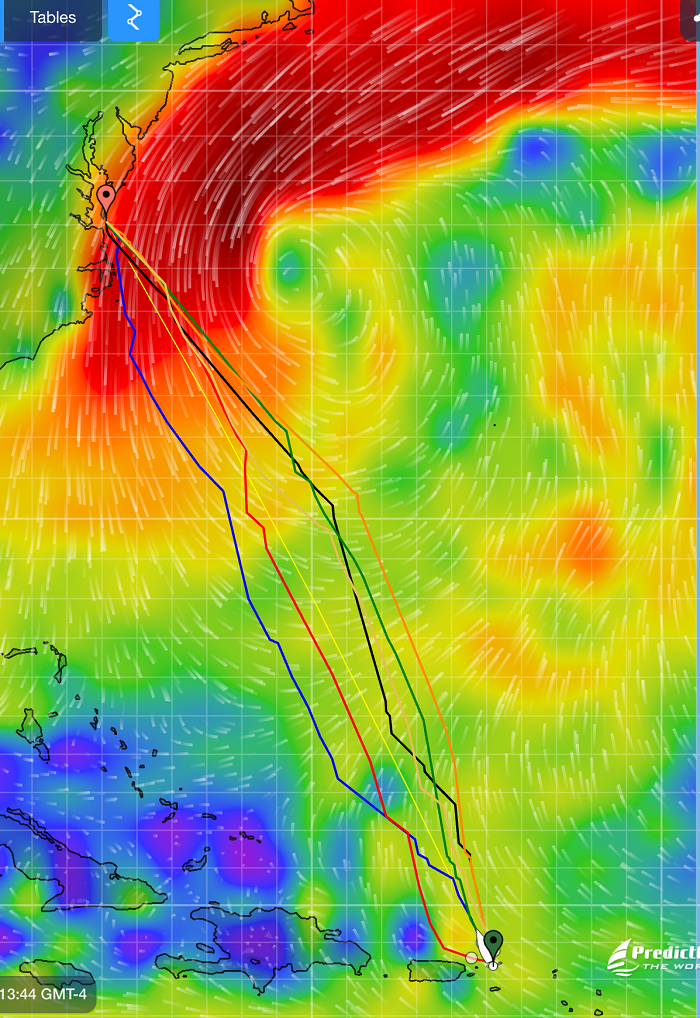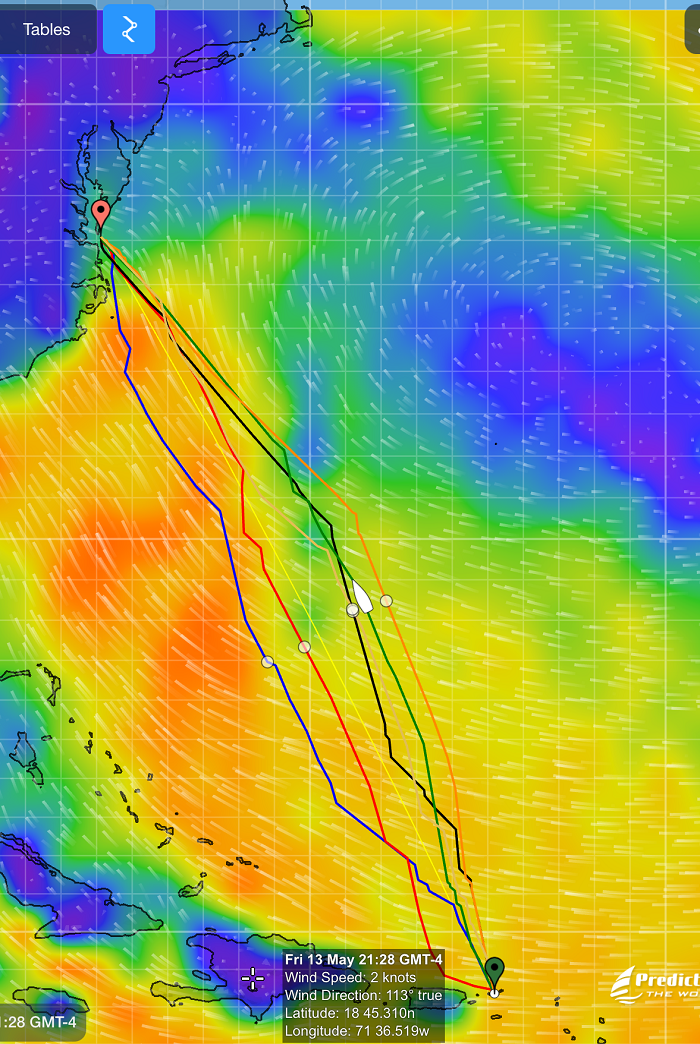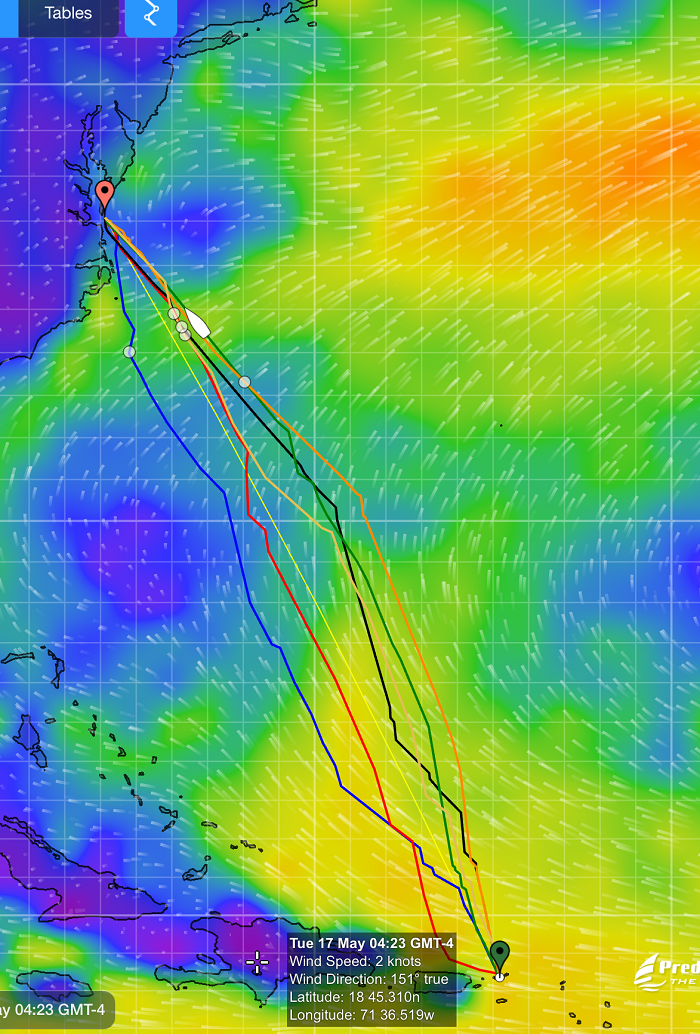Pandora arrived in Deltaville VA this week after an 8 day run from St Thomas. My crew, Craig, Alex and me were part of the Salty Dawg Homeward Bound Rally to the US, along with about 20 boats, most heading to Hampton VA.
The run was fairly uneventful, setting aside minor mechanical issues and a leaking heat exchanger on the engine. All and all a, sort of, uneventful voyage. We did have a very sporty last day before crossing the Gulf Stream when winds picked up to near 30kts for about 12 hours but other than that, we sailed much of the 1,350 miles.
Oddly, after those strong winds and as we approached the Gulf Stream, we had a 180 degree wind shift that took less than a half hour to unfold. At first I thought that it was actually a result of a squall but then realized that the shift was not temporary.
By the time we got to the Gulf Stream, some hours later, the wind had diminished to less than 10kts and we crossed the Stream in near flat calm conditions. It felt more like Long Island Sound in August than the mighty Gulf Stream. It’s all about timing and with Chris Parker’s support, we hit it just right.
As we approached Deltaville, we decided to use the last of our supply of covid tests and learned that all three of us still tested positive. As you can imagine, this was quite upsetting as it had been quite along time since we had tested Alex and learned, a few days out from St Thomas, that he was positive. We assumed that me and Craig were too although we didn’t check ourselves as we didn’t have enough tests on board.
When Craig and Alex first noticed symptoms, we were very upfront with the rally fleet, sending out an an announcement to all that we had been in contact with prior to departure. We didn’t hear anything back so I am assuming that everyone else was ok.
Fortunately, our symptoms were limited to sore throats and a cough and as all of us had been vaccinated and had been twice boosted, the problem was fairly minor.
By the time we got to our destination we were faced with the question about what to say and do about our condition. In my case, we were pretty certain that I was the first to get sick so I was probably no longer a threat to anyone.
I won’t go into any details about what happened next except to say that our arrival was akin to a group of lepers showing up at a garden party for hypochondriacs and it wasn’t pretty. Given the response when word got to them.
I was unsure about how candid to be about our status and ultimately decided not to say anything because I had likely been positive weeks prior and, according to CDC guidelines, was no longer contagious. However, news travels fast and the marina management found out anyway, along with everyone else in the marina.
To say that it was awkward doesn’t begin to describe what happened and it was clear that we were not welcome.
So, the question wasn’t really about if we were still contagious but that we had tested positive, something that I have learned isn’t necessarily a marker for being contagious after enough time has passed . The current science, and CDC guidance, is that you are safe ten days following initial onset of symptoms but public opinion isn’t clear on that at all.
Testing negative isn’t necessarily the marker of safety as omicron, the now dominant variant, can continue to test positive up to 90 days past the initial infection. Based on the reception that we received, good luck trying to explain that when everyone thinks that you can’t reenter society until you have had two days of negative test results.
In the interest of fair balance, I will acknowledge that there are two sides of the story and I should have been more upfront with everyone. Having said that, there is so much emotion and misinformation out there, I doubt that things would have been much different if I’d said something upfront. I guess I’ll never know.
Yup, really awkward.
So, we cleaned up Pandora and left as soon as we could. No reason to hang around when we were clearly not wanted.
Pandora remains in Deltaville awaiting the installation of the lithium bank and some other work to be determined.
Enough of that for now.
Meanwhile… when I’m on passage, I always worry about a catastrophic failure of some sort. Things always break but they are usually little things. When it’s really “sporty” or “salty” as Chris Parker likes to say, I listen to the sounds of the boat and always have in the back of my mind, a fear that the rig is going to fail in some way.
I say this knowing that my standing rigging was replaced two years ago by a very competent rigger but I still worry. Given all the stresses on any boat in a seaway, I am always amazed that Pandora holds together in spite of everything we run into.
However, sometimes things do break but fortunately, Pandora’s failures have been pretty minor.
Last fall one of our rally boats had a major failure when they lost their forestay in pretty rough conditions. I won’t go into detail about this except to say that things turned out fine but several Salty Dawg boats came to the rescue and at one point the USCG came out in a chopper from Puerto Rico as someone on board set off their EPIRB emergency transponder, only to cancel the call by the time the chopper arrived.
Fast forward and that same boat was heading back to New York a few weeks ago and found themselves in pretty rough conditions off of Long Island, this time with terrible results.
I don’t know the specifics except to say that the captain reported to the USCG that they had been hit by a “rouge wave” and lost their entire rig.
The USCG send out a Jayhawk chopper and lifted all four crew to safety. The Coast Guard records video of all operations and to see this footage is very sobering.Check out this link to a news report of the incident from a TV station in Boston.
So, there you have it. Sure we had a good passage but the arrival, not so much.
All I can say is that it didn’t feel good to be greeted like lepers but at least we didn’t have to be rescued by the USCG. Having said that, it’s nice to know that they will be there if we need them.
Let’s hope that’s never the case and I hope to never hear the words, “Good evening, I’ll be your USCG rescue swimmer today”.
Nope, I’d much prefer being a pariah as it could have been much worse.

 In preparation for our run north, beginning tomorrow, Tuesday, we decided to head to a marina in Red Hook, on St Thomas. It’s a lot easier to prepare, getting the dink up on deck and getting provisions from a marina.
In preparation for our run north, beginning tomorrow, Tuesday, we decided to head to a marina in Red Hook, on St Thomas. It’s a lot easier to prepare, getting the dink up on deck and getting provisions from a marina.  The marina is part of the IGY family of marinas, the same company that runs the one in St Lucia that we stayed at in Rodney Bay. Their rates tend to be a bit more reasonable than others. Plenty of services nearby.
The marina is part of the IGY family of marinas, the same company that runs the one in St Lucia that we stayed at in Rodney Bay. Their rates tend to be a bit more reasonable than others. Plenty of services nearby.  The view of nearby St John this morning as the sun came up, was pretty nice.
The view of nearby St John this morning as the sun came up, was pretty nice.  Under the category of “it takes all types” how about this boat near us in the marina. A great party platform, to be sure.
Under the category of “it takes all types” how about this boat near us in the marina. A great party platform, to be sure.  Being in a marina for a few days was a good idea. A bit of luxury, complete with AC, is a good way to begin a long journey.
Being in a marina for a few days was a good idea. A bit of luxury, complete with AC, is a good way to begin a long journey. As we make our way north, conditions continue to be good with favorable winds, and you can see that the nasty low has moved out of the area. We will continue to have wind aft of the beam, and hopefully it will be strong enough to keep us moving at a good speed.
As we make our way north, conditions continue to be good with favorable winds, and you can see that the nasty low has moved out of the area. We will continue to have wind aft of the beam, and hopefully it will be strong enough to keep us moving at a good speed.  Finally, as we approach the US east coast, there is a bit of uncertainty with a weak low forecasted to exit the coast. Again, Chris feels a high degree of confidence that it will not amount to much. Fingers crossed that it will be long gone by the time we cross the gulf stream off of Cape Hatteras and arrive at the mouth of the Chesapeake Bay.
Finally, as we approach the US east coast, there is a bit of uncertainty with a weak low forecasted to exit the coast. Again, Chris feels a high degree of confidence that it will not amount to much. Fingers crossed that it will be long gone by the time we cross the gulf stream off of Cape Hatteras and arrive at the mouth of the Chesapeake Bay.  All and all, it looks like the wind will be favorable for the entire trip if perhaps a bit light at times. Light wind isn’t a huge problem as I have plenty of fuel, so bring it on.
All and all, it looks like the wind will be favorable for the entire trip if perhaps a bit light at times. Light wind isn’t a huge problem as I have plenty of fuel, so bring it on. On this trip I decided to ask what it would cost to tie up on the dock in the inner harbor. I was shocked to learn that it was surprisingly cheap, something like $30/day. Perhaps it’s because it is late in the season as I know that it’s impossible to get in here during the holidays.
On this trip I decided to ask what it would cost to tie up on the dock in the inner harbor. I was shocked to learn that it was surprisingly cheap, something like $30/day. Perhaps it’s because it is late in the season as I know that it’s impossible to get in here during the holidays. Anyway, she’s riding well now. To say that we are close to “town” doesn’t begin to describe it.
Anyway, she’s riding well now. To say that we are close to “town” doesn’t begin to describe it.  Just behind the dock is main street Gustavia, lined with every imaginable high end boutiques.
Just behind the dock is main street Gustavia, lined with every imaginable high end boutiques.  French cheeses and wines are abundant and fairly reasonably priced. The fresh produce in the market, literally 20 steps from our transom, is amazing.
French cheeses and wines are abundant and fairly reasonably priced. The fresh produce in the market, literally 20 steps from our transom, is amazing.  And an endless number of high end restaurants, along with a few for those of us that “have to ask what it costs”, like me.
And an endless number of high end restaurants, along with a few for those of us that “have to ask what it costs”, like me. Here’s a closeup of where she is, the last boat on the string, near all the dinks.
Here’s a closeup of where she is, the last boat on the string, near all the dinks.  We also spied the St Barts Yellow Submarine, a glass bottom boat that you can go out on to view the local reefs. I wonder where it was made. It looks like fun.
We also spied the St Barts Yellow Submarine, a glass bottom boat that you can go out on to view the local reefs. I wonder where it was made. It looks like fun.  Once we were up at the lighthouse, we could look down toward the island airport and watch the crazy approach that planes have to make to land on what appears to be a remarkably short runway.
Once we were up at the lighthouse, we could look down toward the island airport and watch the crazy approach that planes have to make to land on what appears to be a remarkably short runway.  They zip overhead, so close you feel like you could reach up and touch them.
They zip overhead, so close you feel like you could reach up and touch them.  After clearing the ridge, or mountain, at the western end of the runway, they dive down the other side to land. The planes fly at treetop level over the ridge and then go into a steep dive. Yes, it’s that steep. Actually worse than this photo suggests.
After clearing the ridge, or mountain, at the western end of the runway, they dive down the other side to land. The planes fly at treetop level over the ridge and then go into a steep dive. Yes, it’s that steep. Actually worse than this photo suggests.  And then, in seconds, are on the ground.
And then, in seconds, are on the ground. From up on the hill you can peek into the amazing homes that ring the harbor. How about this spot, with “his and hers” pools.
From up on the hill you can peek into the amazing homes that ring the harbor. How about this spot, with “his and hers” pools.  I looked in a real-estate office and, as expected, homes were listed for tens of millions. As you can imagine, the Russian Oligarchs are well represented here, or were before they had to flee due to sanctions.
I looked in a real-estate office and, as expected, homes were listed for tens of millions. As you can imagine, the Russian Oligarchs are well represented here, or were before they had to flee due to sanctions. Being here for a few days, tied up on the dock, so close to town and all the sights, has been a real treat. Hope that Brenda and I will be able to visit here sometime in the future.
Being here for a few days, tied up on the dock, so close to town and all the sights, has been a real treat. Hope that Brenda and I will be able to visit here sometime in the future.